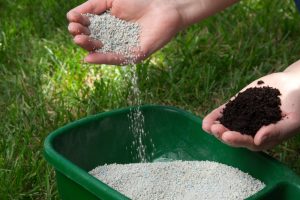What Are The Best Fertilisers For New Lawn Establishment?
Creating a lush and vibrant lawn requires more than just planting seeds. One crucial element in the equation is choosing the right fertiliser for your new lawn. In this comprehensive guide, we’ll delve into the why, how, and what of fertilising your newly established lawn. Also, we’ll demystify fertiliser ratios, explore the best types of lawn fertilisers, compare organic and synthetic options, and uncover the optimal timing and techniques for achieving a flawless lawn.
Why fertilise your new lawn?
A healthy lawn starts from the ground up, and fertilising is the key to providing your grass with the essential nutrients it needs for robust growth. Furthermore, fertilisers contribute crucial elements like nitrogen, phosphorus, and potassium, ensuring your lawn gets off to the right start. But why is fertilising so important?
- Boosts growth: Fertilisers promote strong and rapid grass growth, helping your new lawn establish itself quickly.
- Enhances colour: The right nutrients enhance the vibrant green colour of your grass, giving your lawn a visually appealing look.
- Strengthens roots: Fertilising encourages deep root development, making your lawn more resilient to stress and adverse weather conditions.
- Improves disease resistance: Well-fed lawns are better equipped to fend off diseases, ensuring a healthier and more durable lawn.
What is the process of demystifying fertiliser ratios for new lawns?
Understanding fertiliser ratios may seem like decoding a secret language, but it’s crucial for the success of your new lawn. Here’s a simplified breakdown:
- Nitrogen (N): This nutrient promotes leaf and stem growth. So, opt for a higher nitrogen ratio for a lush, green lawn.
- Phosphorus (P): Essential for root development and flowering. Moreover, choose a balanced phosphorus ratio for new lawns.
- Potassium (K): Enhances overall plant health and disease resistance. In addition, look for a balanced potassium ratio to support your lawn’s well-being.
- Micronutrients: Iron, magnesium, and other micronutrients play a role in various plant functions. Furthermore, ensure your fertiliser contains these for comprehensive lawn nourishment.
Generally, fertiliser packaging commonly presents these ratios in the form of three numbers, like 20-10-10, signifying the proportion of nitrogen, phosphorus, and potassium in that sequence, facilitating easy calculation of nutrient content.
Which type of lawn fertiliser is best for establishing a new lawn?
Choosing the right type of fertiliser is crucial for your new lawn’s success. There are two main categories: granular and liquid fertilisers.
- Granular Fertilisers:
-
- Slow-release nutrients: Ideal for steady and continuous feeding over an extended period.
- Easy application: Simple to spread evenly across the lawn.
- Long-lasting effects: Requires fewer applications throughout the season.
Granular fertilisers come in different formulations, including all-in-one fertilisers or specialised blends focusing on specific needs like weed prevention or root development.
- Liquid Fertilisers:
-
- Quick absorption: Fast-acting for rapid nutrient uptake by the grass.
- Customisable application: Easy to mix and apply, allowing for precise nutrient control.
- Great for spot treatments: Perfect for addressing specific areas with nutrient deficiencies.
Liquid fertilisers are a fantastic choice for those looking for immediate results and the flexibility to target specific areas that may require additional nutrients.
Ultimately, the choice between granular and liquid fertilisers depends on your lawn’s specific needs and your preferred application method.
What’s the best lawn fertiliser: organic or synthetic?
The debate between organic and synthetic fertilisers is ongoing, each with its set of pros and cons.
- Organic Fertilisers:
- Natural nutrients: Organic fertilisers are a product of the natural world, derived from organic matter such as compost, manure, or specially formulated blends. Additionally, these fertilisers boast a rich array of natural nutrients that not only nourish your grass but also contribute to the overall health of the soil.
- Slow release: One of the distinctive features of organic fertilisers is their slow-release nature. Basically, this means that the nutrients are gradually released over time, providing your lawn with a sustained and long-lasting supply of essential elements. Also, this gradual release aligns with the natural pace of plant growth, fostering a steady and healthy development.
- Environmentally friendly: For eco-conscious gardeners, organic fertilisers present a compelling choice. Being derived from natural sources, they are generally less harmful to the environment compared to their synthetic counterparts. In addition, the use of organic options contributes to the sustainability of your gardening practices and promotes a harmonious relationship with nature.
Organic options include compost, manure, or specially formulated organic fertilisers. Moreover, they work in harmony with the soil ecosystem, enhancing its structure and microbial activity.
- Synthetic Fertilisers:
- Fast-acting: Synthetic fertilisers are renowned for their immediate impact on the lawn. Furthermore, they contain readily available nutrients that are quickly absorbed by the grass, leading to rapid and visible results. Additionally, this characteristic is particularly beneficial for those seeking a quick fix or looking to address specific nutrient deficiencies promptly.
- Precise nutrient content: One of the advantages of synthetic fertilisers lies in their precise formulations. Generally, these fertilisers are engineered to provide an exact nutrient balance, allowing for targeted delivery of the elements your lawn needs. Also, this precision is valuable for customising your fertilisation approach based on the specific requirements of your grass.
- Convenience: In the hustle and bustle of modern life, convenience is often a deciding factor. Basically, synthetic fertilisers score high in this regard. Additionally, they are easy to apply and generally require less volume compared to organic options. Also, this makes them a practical choice for busy gardeners seeking efficiency in their lawn care routine.
Generally, synthetic fertilisers are formulated to provide specific nutrient ratios, ensuring your lawn gets precisely what it needs. While convenient and effective, they may contribute to environmental concerns if overused.
In the end, the choice between organic and synthetic fertilisers depends on your gardening philosophy, environmental concerns, and the specific needs of your lawn.
What are the optimal timing and techniques for achieving flawless fertilising?
Fertilising at the right time and using proper techniques are crucial for optimal results.
- Timing:
- Early spring: Kickstart the growing season with a balanced fertiliser to support initial growth.
- Late spring: Apply a fertiliser with higher nitrogen content to enhance colour and density.
- Early fall: Strengthen your lawn for the winter months with a phosphorus-rich fertiliser.
Understanding your local climate and the type of grass in your lawn is essential for timing your fertilisation correctly. Also, some lawns may benefit from an additional mid-summer feeding to combat stress.
- Techniques:
- Even application: Use a spreader to ensure an even distribution of the fertiliser.
- Watering in: Water the lawn after application to help nutrients reach the soil and roots.
- Avoid overfertilising: Follow recommended application rates to prevent damage to your lawn.
Overfertilising can harm your lawn, causing burns and negatively impacting its health. Furthermore, following recommended guidelines and adjusting based on your lawn’s response is key to success.
Conclusion
In summary, choosing the best fertiliser for your new lawn involves understanding its nutritional needs, deciphering fertiliser ratios, selecting between organic and synthetic options, and applying them at the right time and with proper techniques. Additionally, achieving a flawless lawn requires a thoughtful approach to lawn care.
For further assistance in turning your new lawn into a green masterpiece, consider reaching out to A Bargain Gardener. Our expert team is dedicated to helping you achieve a lawn that’s not only healthy but also a delight to the eyes. Furthermore, we offer professional fertilising services tailored to your lawn’s specific needs.
So, don’t let your lawn miss out on the nutrients it deserves. Contact us today, and let’s turn your lawn into the envy of the neighbourhood. Remember, a well-fed lawn is a happy lawn. Happy gardening, mate!




